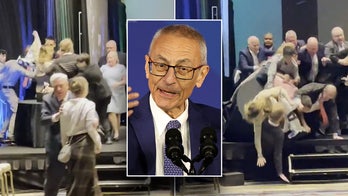SACRAMENTO, Calif. – Gov. Jerry Brown's administration on Friday petitioned the California Supreme Court to overturn two lower-court rulings that have stalled progress on the state's high-speed rail project, one of the nation's most expensive public works projects.
The petition seeks an expedited review and asks the court to overturn two decisions that prevented the state from selling $8.6 billion in voter-approved bonds. The lower-court rulings also require the high-speed rail authority to write a new financing plan.
The governor, the rail authority and the state treasurer argue that the rulings prevent California from quickly starting construction on the $68 billion project and could hurt the state's ability to finance other voter-approved projects in the future, a change of course for the officials, who previously said the rulings wouldn't significantly affect the project.
"The trial court's approach to these issues cripples government's ability to function," the 49-page petition filed late Friday said. "The rulings thwart the intent of the voters and the Legislature to finance the construction of high-speed rail, and do so in a manner that has implications for other important infrastructure projects."
A Sacramento County Superior Court judge last year sided with opponents, who claimed the state failed to comply with the promises made to voters when they approved Proposition 1A in 2008.
He rescinded the rail authority's funding plan, ordered it to get more environmental clearances and show how it will pay for the first 300 miles of work, which is estimated to cost about $31 billion.
Stuart Flashman, one of the attorneys for the Central Valley landowners who sued the rail authority, called the state's request to the high court unprecedented and "mind-boggling."
"They're basically saying the courts have no right to do anything to stop this project," Flashman said. "When you think about it, it's incredibly disrespectful to the judiciary, very in-your-face, just -- `Shut up and let us go do what we want."'
Friday's urgent filing casting the judge's rulings as potentially devastating to the project is at odds with repeated claims made by high-speed rail officials and the governor. Rail authority CEO Jeff Morales said after the judge's November ruling that addressing the judge's concerns would not take long and that he did not think it would "have any material effect on the project."
The state's petition says that if the Supreme Court does not review the case, allow the state to sell bonds and proceed with construction, "the future of the high-speed rail system may effectively be determined by two superior court rulings untethered from the law approved by the Legislature and the voters to build it."
Plans to build a 520-mile network linking Northern and Southern California have been plagued by years of legal and political setbacks. Construction that was scheduled to begin in the Central Valley in spring 2013 is now forecast to start sometime this spring. The state financing plan had relied upon significant federal investments to prop up the project, but congressional Republicans have effectively blocked further high-speed rail funding.
The federal government has awarded $3.5 billion in grants to the project, including $2.5 billion in federal stimulus money that requires a dollar-for-dollar match and must be spent by 2017. But without access to the voter-approved bonds, California has been unable to make its matching payments.
Federal officials testified during a recent hearing in Washington, D.C., that the funding could be halted if California does not make a $180 million contribution due in May.
In an unrelated development earlier Friday, the rail authority and Amtrak released a joint request for proposals to build trains for California's planned bullet train and Amtrak's Northeast Corridor.
The request calls for 15 so-called "trainsets," which can travel at minimum speeds of 200 mph, for the high-speed rail project, and 28 trainsets for Amtrak's Acela line, which runs between Boston and Washington, D.C. Each trainset will have 400 to 450 seats distributed throughout several cars, determined by the bidders.
Unlike on a conventional train, the engines will be distributed throughout the cars.




